MCNet: Multi-Scale Feature Extraction and Content-Aware Reassembly Cloud Detection Model for Remote Sensing Images
Abstract
1. Introduction
- The remote sensing cloud image obtained in the real scene contains many surface objects (such as snow, ice, trees, and white human-made objects) with similar reflection characteristics to the clouds, and the background interference is serious. As a result, it is challenging to capture clouds under a large amount of background interference accurately.
- The uneven distribution and thickness of clouds in remote sensing images make the detection accuracy low.
- Clouds are affected by shooting angles and wind speeds, resulting in different scales and various shapes, and the accuracy of cloud mask generation in complex scenes is low.
- To solve the detection problems of uneven cloud layer thickness, uneven cloud layer distribution, and background interference, a pyramidal convolution residual network with an efficient channel attention (ECA) module (EPResNet-50) is proposed, which uses pyramidal convolution [32] to capture multi-scale feature information and increase the network’s attention to effective channels through the ECA [33] module, comprehensively consider the channel characteristics and spatial characteristics, and enhance the ability of network feature extraction.
- To solve the problem of low accuracy of cloud generation masks in complex scenes, the CARAFE (Content-Aware ReAssembly of FEatures) [34] upsampling module is introduced. The semantic information of feature maps is fully utilized for feature restoration through adaptive kernels, and the accuracy of network generation masks is improved.
2. Methods
2.1. MCNet
2.2. EPResNet-50
2.2.1. Pyramidal Convolution
2.2.2. ECA
2.2.3. EPResNet-50 Architectures
2.3. CARAFE
3. Experiments
3.1. Datasets
3.2. Evaluation Metrics
3.3. Experimental Details
3.4. Experimental Result Analysis
3.4.1. Ablation Experiment
3.4.2. Comparison with Some Popular Methods
4. Conclusions
Author Contributions
Funding
Conflicts of Interest
References
- Yang, Y. Resilient PNT Concept Frame. J. Geod. Geoinf. Sin. 2019, 2, 1–7. [Google Scholar]
- Yang, Y. Concepts of comprehensive PNT and related key technologies. Acta Geod. Cartogr. Sin. 2016, 45, 505–510. [Google Scholar]
- Cleve, C.; Kelly, M.; Kearns, F.R.; Moritz, M. Classification of the wildland–urban interface: A comparison of pixel-and object-based classifications using high-resolution aerial photography. Comput. Environ. Urban Syst. 2008, 32, 317–326. [Google Scholar] [CrossRef]
- Mena, J.B. State of the art on automatic road extraction for GIS update: A novel classification. Pattern Recognit. Lett. 2003, 24, 3037–3058. [Google Scholar] [CrossRef]
- Friedrich, T.; Oschlies, A. Neural network-based estimates of North Atlantic surface pCO2 from satellite data: A methodological study. J. Geophys. Res. Ocean. 2009, 114. [Google Scholar] [CrossRef]
- Hall, R.; Skakun, R.; Arsenault, E.; Case, B. Modeling forest stand structure attributes using Landsat ETM+ data: Application to mapping of aboveground biomass and stand volume. For. Ecol. Manag. 2006, 225, 378–390. [Google Scholar] [CrossRef]
- Schiffer, R.A.; Rossow, W.B. The International Satellite Cloud Climatology Project (ISCCP): The first project of the world climate research programme. Bull. Am. Meteorol. Soc. 1983, 64, 779–784. [Google Scholar] [CrossRef]
- Price, J.C. Land surface temperature measurements from the split window channels of the NOAA 7 Advanced Very High Resolution Radiometer. J. Geophys. Res. Atmos. 1984, 89, 7231–7237. [Google Scholar] [CrossRef]
- Li, W.; Li, D. The universal cloud detection algorithm of MODIS data. In Proceedings of the Geoinformatics 2006: Remotely Sensed Data and Information, Wuhan, China, 28–29 October 2006; Volume 6419, p. 64190F. [Google Scholar] [CrossRef]
- Wu, X.; Cheng, Q. Study on methods of cloud identification and data recovery for MODIS data. In Proceedings of the Remote Sensing of Clouds and the Atmosphere XII, Florence, Italy, 17–20 September 2007; Volume 6745, p. 67450P. [Google Scholar] [CrossRef]
- Ren, R.; Guo, S.; Gu, L.; Wang, L.; Wang, X. An effective method for the detection and removal of thin clouds from MODIS image. In Proceedings of the Satellite Data Compression, Communication, and Processing V, San Diego, CA, USA, 2–6 August 2009; Volume 7455, p. 74550Z. [Google Scholar] [CrossRef]
- Solvsteen, C. Correlation-based cloud detection and an examination of the split-window method. In Proceedings of the Global Process Monitoring and Remote Sensing of the Ocean and Sea Ice, Paris, France, 25–28 September 1995; Volume 2586, pp. 86–97. [Google Scholar] [CrossRef]
- Ping, Q.W.; Qing, L.W.; Guo, L.J.; Huai, L.Y.; Jun, Z.; Min, Q.; Cheng, L. Application of Single-Band Brightness Variance Ratio to the Interference Dissociation of Cloud for Satellite Data. Spectrosc. Spectr. Anal. 2006, 26, 2011–2015. [Google Scholar]
- Shan, N.; Zheng, T.; Wang, Z. High-speed and high-accuracy algorithm for cloud detection and its application. J. Remote Sens. 2009, 13, 1138–1146. [Google Scholar]
- Chen, P.; Zhang, R.; Liu, Z. Feature detection for cloud classification in remote sensing images. J. Univ. Ence Technol. China 2009, 5, 484–488. [Google Scholar]
- Zhu, Z.; Woodcock, C.E. Object-based cloud and cloud shadow detection in Landsat imagery. Remote Sens. Environ. 2012, 118, 83–94. [Google Scholar] [CrossRef]
- Zhu, Z.; Wang, S.; Woodcock, C.E. Improvement and expansion of the Fmask algorithm: Cloud, cloud shadow, and snow detection for Landsats 4–7, 8, and Sentinel 2 images. Remote Sens. Environ. 2015, 159, 269–277. [Google Scholar] [CrossRef]
- Qiu, S.; Zhu, Z.; He, B. Fmask 4.0: Improved cloud and cloud shadow detection in Landsats 4–8 and Sentinel-2 imagery. Remote Sens. Environ. 2019, 231, 111205. [Google Scholar] [CrossRef]
- Irish, R.R.; Barker, J.L.; Goward, S.N.; Arvidson, T. Characterization of the Landsat-7 ETM+ automated cloud-cover assessment (ACCA) algorithm. Photogramm. Eng. Remote Sens. 2006, 72, 1179–1188. [Google Scholar] [CrossRef]
- Latry, C.; Panem, C.; Dejean, P. Cloud detection with SVM technique. In Proceedings of the 2007 IEEE International Geoscience and Remote Sensing Symposium, Barcelona, Spain, 23–28 July 2007; pp. 448–451. [Google Scholar]
- Shelhamer, E.; Long, J.; Darrell, T. Fully convolutional networks for semantic segmentation. IEEE Trans. Pattern Anal. Mach. Intell. 2017, 39, 640–651. [Google Scholar] [CrossRef]
- Mohajerani, S.; Krammer, T.A.; Saeedi, P. Cloud detection algorithm for remote sensing images using fully convolutional neural networks. arXiv 2018, arXiv:1810.05782. [Google Scholar]
- Mohajerani, S.; Saeedi, P. Cloud-Net: An end-to-end cloud detection algorithm for Landsat 8 imagery. In Proceedings of the IGARSS 2019—2019 IEEE International Geoscience and Remote Sensing Symposium, Yokohama, Japan, 28 July–2 August 2019; pp. 1029–1032. [Google Scholar]
- Chen, L.C.; Papandreou, G.; Kokkinos, I.; Murphy, K.; Yuille, A.L. Deeplab: Semantic image segmentation with deep convolutional nets, atrous convolution, and fully connected crfs. IEEE Trans. Pattern Anal. Mach. Intell. 2017, 40, 834–848. [Google Scholar] [CrossRef]
- Segal-Rozenhaimer, M.; Li, A.; Das, K.; Chirayath, V. Cloud detection algorithm for multi-modal satellite imagery using convolutional neural-networks (CNN). Remote Sens. Environ. 2020, 237, 111446. [Google Scholar] [CrossRef]
- Zhao, H.; Shi, J.; Qi, X.; Wang, X.; Jia, J. Pyramid scene parsing network. In Proceedings of the IEEE Conference on Computer Vision and Pattern Recognition, Honolulu, HI, USA, 21–26 July 2017; pp. 2881–2890. [Google Scholar]
- Yan, Z.; Yan, M.; Sun, H.; Fu, K.; Hong, J.; Sun, J.; Zhang, Y.; Sun, X. Cloud and cloud shadow detection using multilevel feature fused segmentation network. IEEE Geosci. Remote Sens. Lett. 2018, 15, 1600–1604. [Google Scholar] [CrossRef]
- Ronneberger, O.; Fischer, P.; Brox, T. U-net: Convolutional networks for biomedical image segmentation. In International Conference on Medical Image Computing and Computer-Assisted Intervention; Springer: Cham, Switzerland, 2015; pp. 234–241. [Google Scholar]
- Gonzales, C.; Sakla, W. Semantic Segmentation of Clouds in Satellite Imagery Using Deep Pre-trained U-Nets; Technical Report; Lawrence Livermore National Lab. (LLNL): Livermore, CA, USA, 2019.
- He, K.; Zhang, X.; Ren, S.; Sun, J. Deep residual learning for image recognition. In Proceedings of the IEEE Conference on Computer Vision and Pattern Recognition, Las Vegas, NV, USA, 26 June–1 July 2016; pp. 770–778. [Google Scholar]
- Guo, Y.; Cao, X.; Liu, B.; Gao, M. Cloud Detection for Satellite Imagery Using Attention-Based U-Net Convolutional Neural Network. Symmetry 2020, 12, 1056. [Google Scholar] [CrossRef]
- Duta, I.C.; Liu, L.; Zhu, F.; Shao, L. Pyramidal Convolution: Rethinking Convolutional Neural Networks for Visual Recognition. arXiv 2020, arXiv:2006.11538. [Google Scholar]
- Wang, Q.; Wu, B.; Zhu, P.; Li, P.; Zuo, W.; Hu, Q. ECA-net: Efficient channel attention for deep convolutional neural networks. In Proceedings of the IEEE/CVF Conference on Computer Vision and Pattern Recognition, Seattle, WA, USA, 13–19 June 2020; pp. 11534–11542. [Google Scholar]
- Wang, J.; Chen, K.; Xu, R.; Liu, Z.; Loy, C.C.; Lin, D. Carafe: Content-aware reassembly of features. In Proceedings of the IEEE International Conference on Computer Vision, Long Beach, CA, USA, 16–20 June 2019; pp. 3007–3016. [Google Scholar]
- Roy, D.P.; Wulder, M.A.; Loveland, T.R.; Woodcock, C.; Allen, R.G.; Anderson, M.C.; Helder, D.; Irons, J.R.; Johnson, D.M.; Kennedy, R.; et al. Landsat-8: Science and product vision for terrestrial global change research. Remote Sens. Environ. 2014, 145, 154–172. [Google Scholar] [CrossRef]
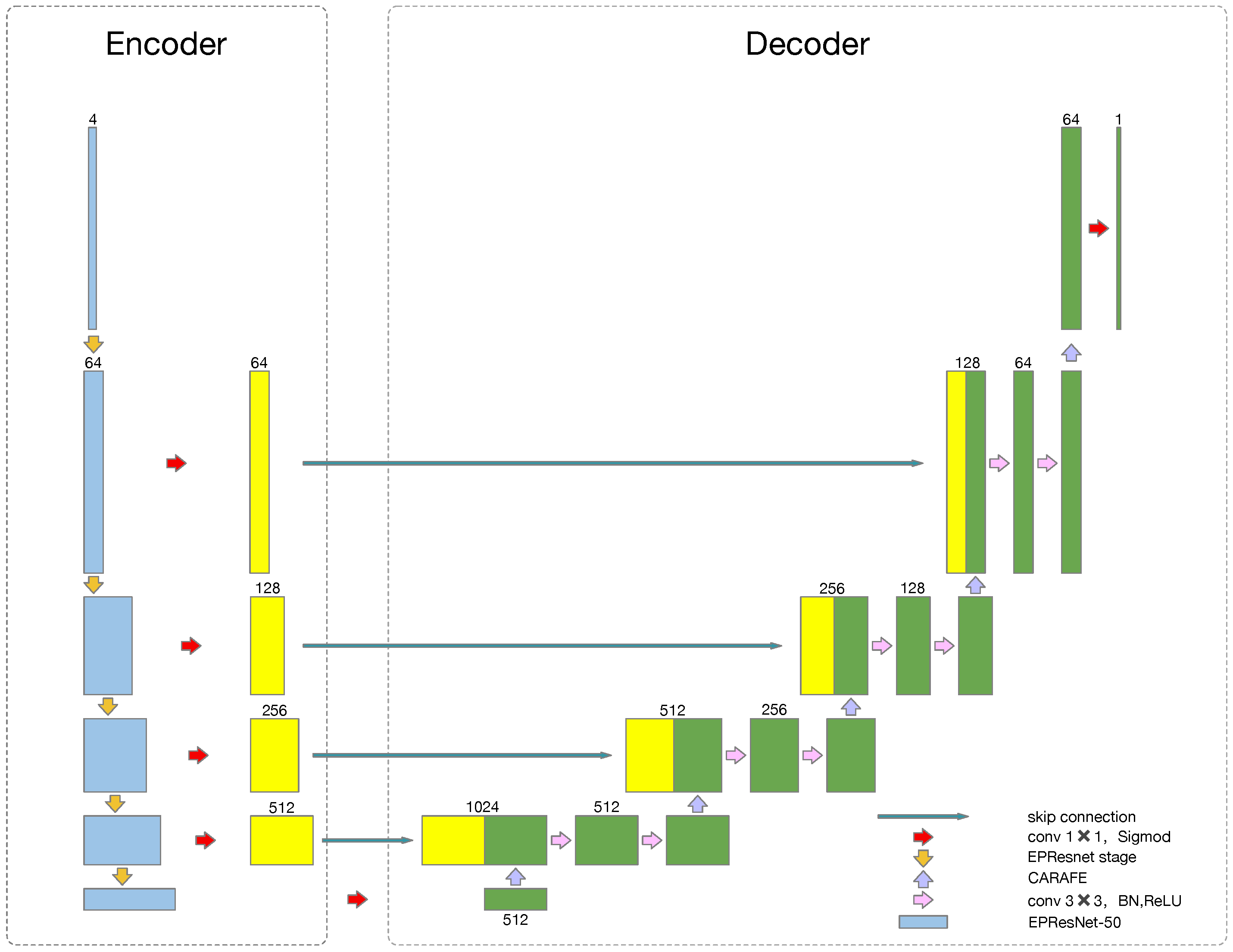

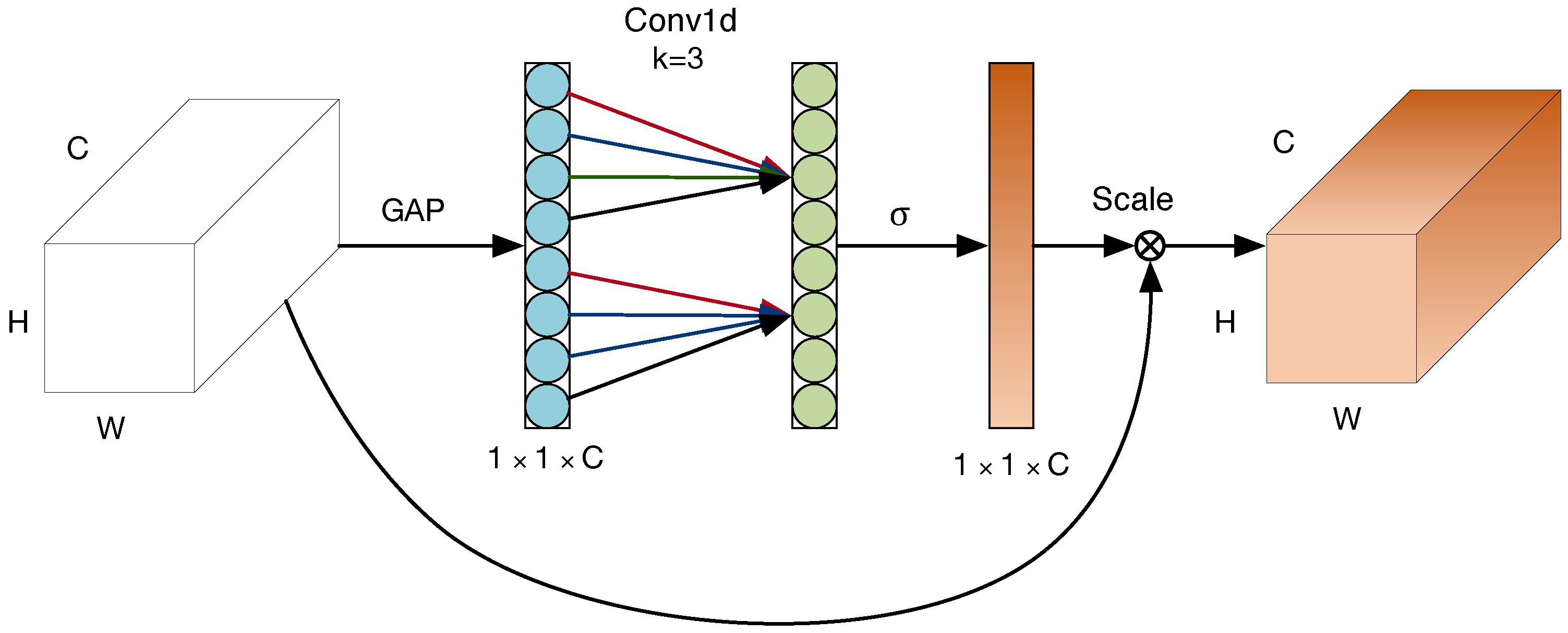
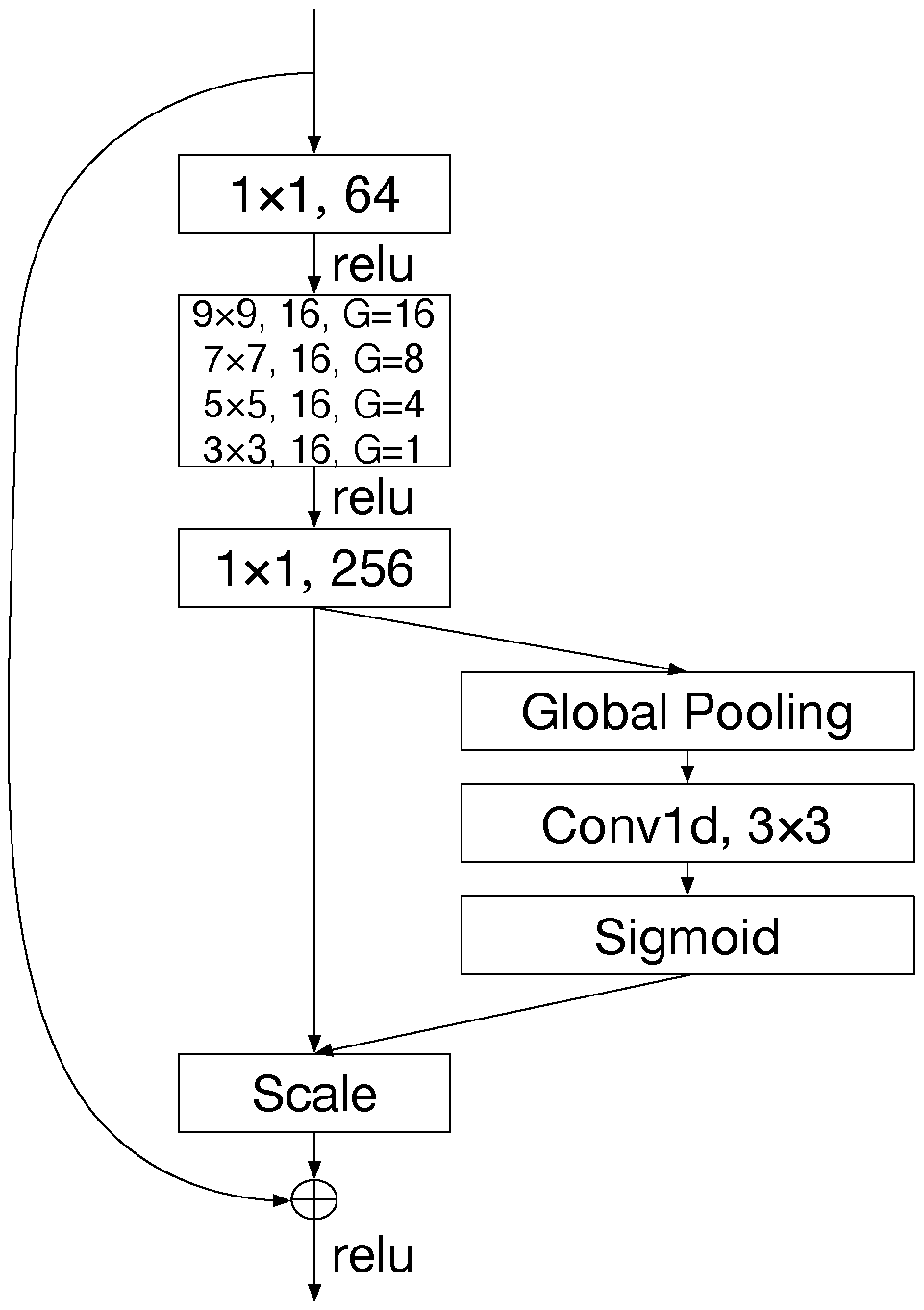
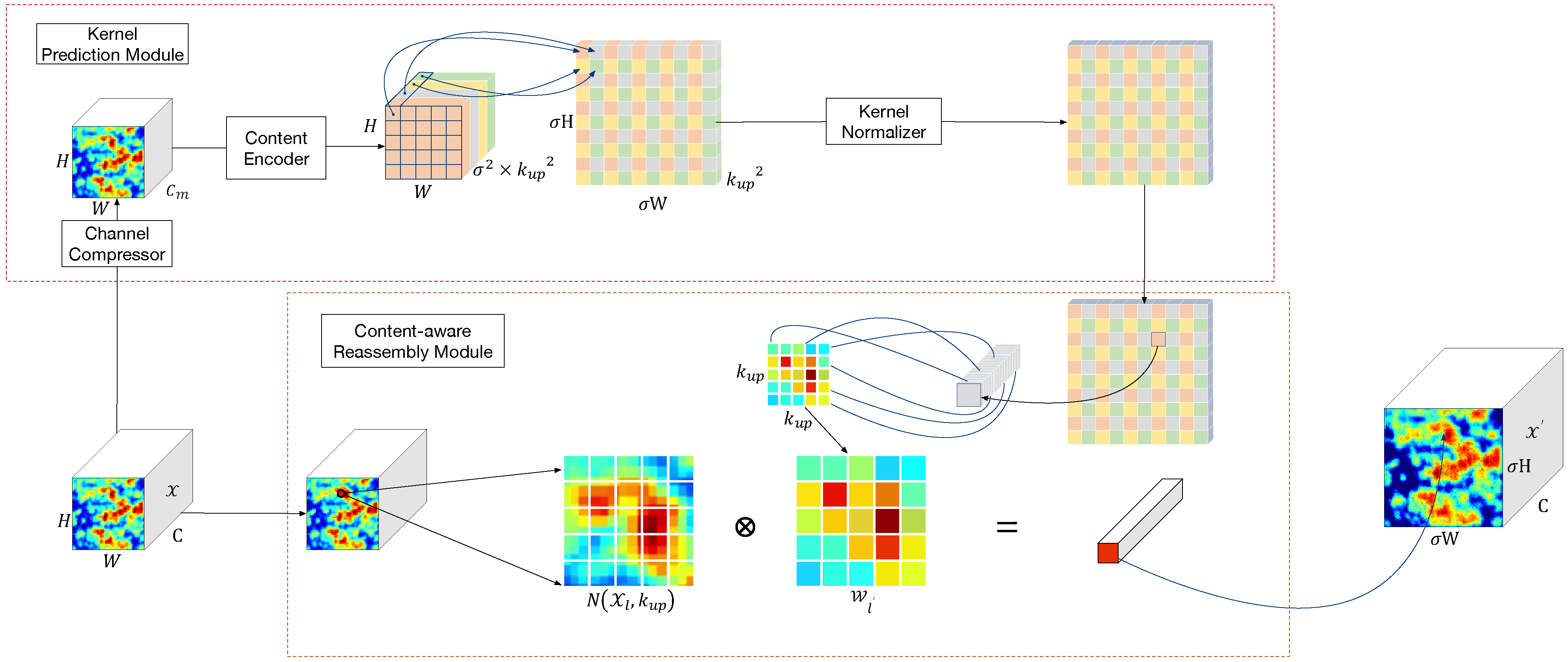
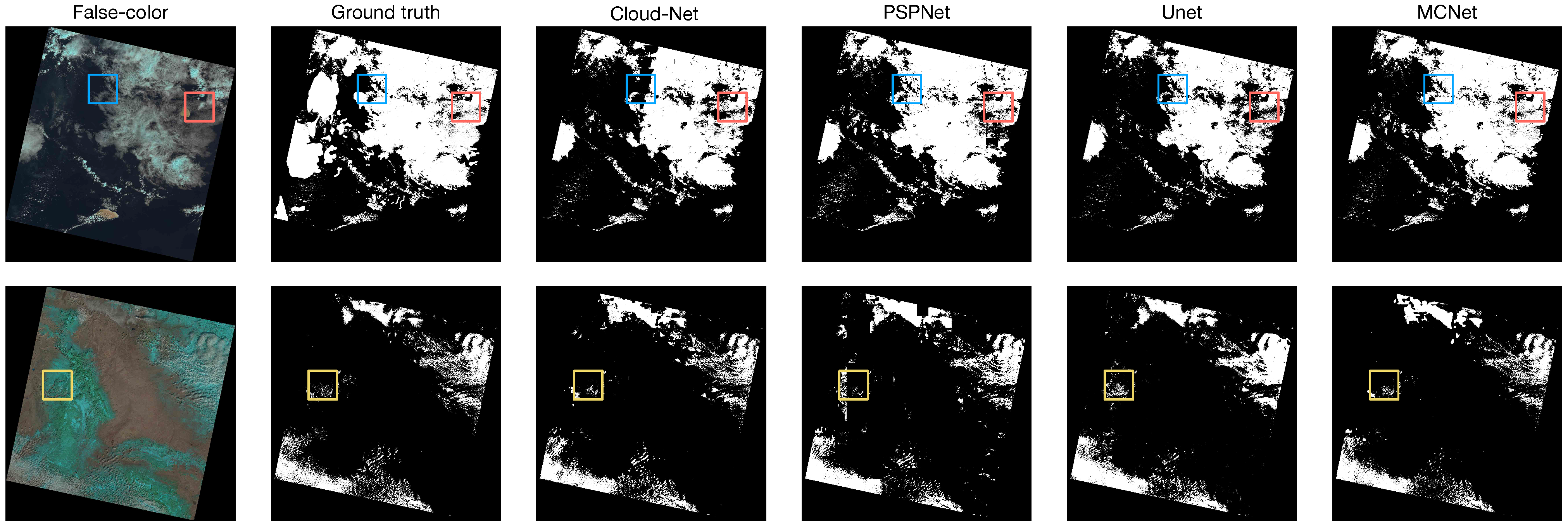


| Stage | Output | ResNet-50 | EPResNet-50 |
|---|---|---|---|
| 0 | |||
| 1 | |||
| 2 | |||
| 3 | |||
| 4 |
| Spectral Bands | Wavelength (m) | Resolution (m) |
|---|---|---|
| Band 1—Ultra Blue | 0.435–0.451 | 30 |
| Band 2—Blue | 0.452–0.512 | 30 |
| Band 3—Green | 0.533–0.590 | 30 |
| Band 4—Red | 0.636–0.673 | 30 |
| Band 5—Near Infrared | 0.851–0.879 | 30 |
| Band 6—Shortwave Infrared 1 | 1.566–1.651 | 30 |
| Band 7 -Shortwave Infrared 2 | 2.107–2.294 | 30 |
| Band 8—Panchromatic | 0.503–0.676 | 15 |
| Band 9—Cirrus | 1.363–1.384 | 30 |
| Band 10—Thermal Infrared 1 | 10.60–11.19 | 30 |
| Band 11—Thermal Infrared 2 | 11.50–12.51 | 30 |
| ECA | PyConv | CARAFE | Jaccard Index [%] | Precision [%] | Recall [%] | Specificity [%] | Overall Accuracy [%] | F1-Score [%] |
|---|---|---|---|---|---|---|---|---|
| 78.00 | 86.61 | 87.92 | 98.65 | 96.30 | 87.26 | |||
| √ | 78.58 | 90.89 | 84.40 | 98.59 | 96.37 | 87.52 | ||
| √ | 80.62 | 94.43 | 84.50 | 98.87 | 96.47 | 89.19 | ||
| √ | 79.46 | 90.71 | 85.95 | 98.67 | 96.15 | 88.27 | ||
| √ | √ | 80.94 | 92.76 | 86.01 | 98.48 | 96.45 | 89.26 | |
| √ | √ | 80.63 | 92.74 | 86.06 | 98.43 | 96.50 | 89.28 | |
| √ | √ | 81.20 | 92.69 | 86.11 | 98.59 | 96.53 | 89.28 | |
| √ | √ | √ | 83.05 | 94.83 | 86.69 | 98.67 | 96.49 | 90.58 |
| Method | Jaccard Index [%] | Precision [%] | Recall [%] | Specificity [%] | Overall Accuracy [%] | F1-Score [%] |
|---|---|---|---|---|---|---|
| GBC | 51.77 | 65.34 | 66.78 | 88.74 | 83.49 | 66.05 |
| RF | 56.52 | 71.65 | 68.12 | 91.79 | 87.11 | 69.84 |
| FCN | 72.17 | 84.59 | 81.37 | 98.45 | 95.23 | 82.95 |
| Fmask | 75.16 | 77.71 | 97.22 | 93.96 | 94.89 | 86.38 |
| Cloud-net | 78.50 | 91.23 | 84.85 | 98.67 | 96.48 | 87.92 |
| Att-unet | 74.54 | 87.27 | 84.59 | 96.74 | 94.63 | 85.91 |
| PSPNet | 79.36 | 87.12 | 86.09 | 96.97 | 96.08 | 86.60 |
| Deeplabv3 | 74.20 | 92.33 | 78.30 | 98.55 | 95.45 | 84.74 |
| Unet | 76.20 | 84.47 | 87.91 | 97.13 | 95.72 | 86.16 |
| MCNet | 83.05 | 94.83 | 86.69 | 98.67 | 96.49 | 90.58 |
Publisher’s Note: MDPI stays neutral with regard to jurisdictional claims in published maps and institutional affiliations. |
© 2020 by the authors. Licensee MDPI, Basel, Switzerland. This article is an open access article distributed under the terms and conditions of the Creative Commons Attribution (CC BY) license (http://creativecommons.org/licenses/by/4.0/).
Share and Cite
Yao, Z.; Jia, J.; Qian, Y. MCNet: Multi-Scale Feature Extraction and Content-Aware Reassembly Cloud Detection Model for Remote Sensing Images. Symmetry 2021, 13, 28. https://doi.org/10.3390/sym13010028
Yao Z, Jia J, Qian Y. MCNet: Multi-Scale Feature Extraction and Content-Aware Reassembly Cloud Detection Model for Remote Sensing Images. Symmetry. 2021; 13(1):28. https://doi.org/10.3390/sym13010028
Chicago/Turabian StyleYao, Ziqiang, Jinlu Jia, and Yurong Qian. 2021. "MCNet: Multi-Scale Feature Extraction and Content-Aware Reassembly Cloud Detection Model for Remote Sensing Images" Symmetry 13, no. 1: 28. https://doi.org/10.3390/sym13010028
APA StyleYao, Z., Jia, J., & Qian, Y. (2021). MCNet: Multi-Scale Feature Extraction and Content-Aware Reassembly Cloud Detection Model for Remote Sensing Images. Symmetry, 13(1), 28. https://doi.org/10.3390/sym13010028






